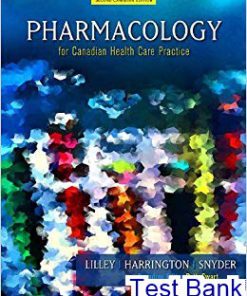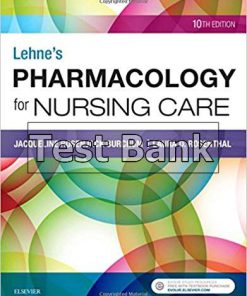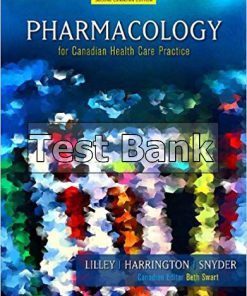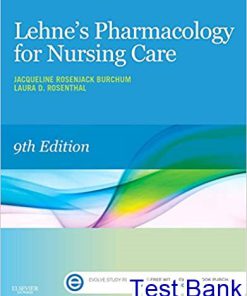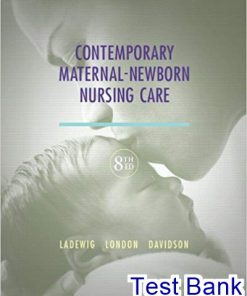Pharmacology for Nursing Care 8th Edition Lehne Test Bank
You may also like
Instant download Pharmacology for Nursing Care 8th Edition Lehne Test Bank pdf docx epub after payment.
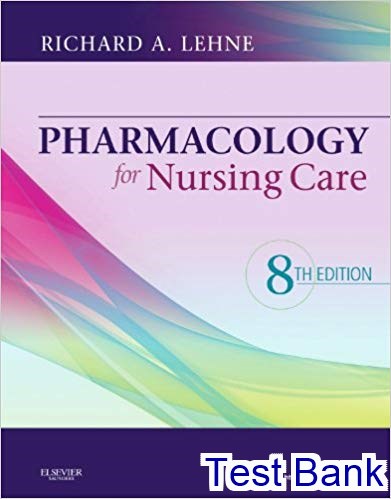
Product details:
- ISBN-10 : 1437735827
- ISBN-13 : 978-1437735826
- Author:
A favorite among nursing students, Pharmacology for Nursing Care, 8th Edition, features a uniquely engaging writing style, clear explanations, and unmatched clinical precision and currency to help you gain a solid understanding of key drugs and their implications — as opposed to just memorization of certain facts. Compelling features such as a drug prototype approach, use of large and small print to distinguish need-to-know versus nice-to-know content, and a focus on major nursing implications save you study time by directing your attention on the most important, need-to-know information. The new edition also features an abundance of content updates to keep you ahead of the curve in school and in professional practice.
Table of contents:
- I. Introduction : Orientation to pharmacology ; Application of pharmacology in nursing practice ; Drug regulation, development, names, and information
- II. Basic principles of pharmacology : Pharmacokinetics ; Pharmacodynamics ; Drug interactions ; Adverse drug reactions and medication errors ; Individual variation in drug responses
- III. Drug therapy across the life span : Drug therapy during pregnancy and breast-feeding ; Drug therapy in pediatric patients ; Drug therapy in geriatric patients
- IV. Peripheral nervous system drugs : Basic principles of neuropharmacology ; Physiology of the peripheral nervous system ; Muscarinic agonists and antagonists ; Cholinesterase inhibitors and their use in myasthenia gravis ; Drugs that block nicotinic cholinergic transmission: neuromuscular blocking agents and ganglionic blocking agents ; Adrenergic agonists ; Adrenergic antagonists ; Indirect-acting antiadrenergic agents
- V. Central nervous system drugs : Introduction to central nervous system pharmacology ; Drugs for Parkinson’s disease ; Alzheimer’s disease ; Drugs for multiple sclerosis ; Drugs for epilepsy ; Drugs for muscle spasm and spasticity ; Local anesthetics ; General anesthetics ; Opioid (narcotic) analgesics, opioid antagonists, and nonopioid centrally acting analgesics ; Pain management in patients with cancer ; Drugs for headache ; Antipsychotic agents and their use in schizophrenia ; Antidepressants ; Drugs for bipolar disorder ; Sedative-hypnotic drugs ; Management of anxiety disorders ; Central nervous system stimulants and attention-deficit/hyperactivity disorder ; Drug abuse I: Basic considerations ; Drug abuse II: Alcohol ; Drug abuse III: Nicotine and smoking ; Drug abuse IV: Major drugs of abuse other than alcohol and nicotine.
- VI. Drugs that affect fluid and electrolyte balance : Diuretics ; Agents affecting the volume and ion content of body fluids
- VII. Drugs that affect the heart, blood vessels, and blood : Review of hemodynamics ; Drugs acting on the renin-angiotensin-aldosterone system ; Calcium channel blockers ; Vasodilators ; Drugs for hypertension ; Drugs for heart failure ; Antidysrhythmic drugs ; Prophylaxis of coronary heart disease: drugs that help normalize cholesterol and triglyceride levels ; Drugs for angina pectoris ; Anticoagulant, antiplatelet, and thrombolytic drugs ; Management of ST-elevation myocardial infarction ; Drugs for hemophilia ; Drugs for deficiency anemias ; Hematopoietic agents
- VIII. Drugs for endocrine disorders : Drugs for diabetes mellitus ; Drugs for thyroid disorders ; Drugs related to hypothalamic and pituitary function ; Drugs for disorders of the adrenal cortex
- IX. Women’s health : Estrogens and progestins: basic pharmacology and noncontraceptive applications ; Birth control ; Drug therapy of infertility ; Drugs that affect uterine function
- X. Men’s health : Androgens ; Drugs for erectile dysfunction and benign prostatic hyperplasia
- XI. Anti-inflammatory, antiallergic, and immunologic drugs : Review of the immune system ; Childhood immunization ; Immunosuppresants ; Antihistamines ; Cyclooxygenase inhibitors: nonsteroidal anti-inflammatory drugs and acetaminophen ; Glucocorticoids in nonendocrine disorders
- XII. Drugs for bone and joint disorders : Drug therapy of rheumatoid arthritis ; Drug therapy of gout ; Drugs affecting calcium levels and bone mineralization
- XIII. Respiratory tract drugs : Drugs for asthma ; Drugs for allergic rhinitis, cough, and colds
- XIV. Gastrointestinal drugs : Drugs for peptic ulcer disease ; Laxatives ; Other gastrointestinal drugs.
- XV. Nutrition : Vitamins ; Drugs for weight loss
- XVI. Chemotherapy of infectious diseases : Basic principles of antimicrobial therapy ; Drugs that weaken the bacterial cell wall I: penicillins ; Drugs that weaken the bacterial cell wall II: cephalosporins, carbapenems, vancomycin, telavancin, aztreonam, teicoplanin, and fosfomycin
- Bacteriostatic inhibitors of protein synthesis: tetracyclines, macrolides, and others ; Aminoglycosides: bactericidal inhibitors of protein synthesis ; Sulfonamides and trimethoprim ; Drug therapy of urinary tract infections ; Antimycobacterial agents: drugs for tuberculosis, leprosy, and Mycobacterium avium complex infection ; Miscellaneous antibacterial drugs: fluoroquinolones, metronidazole, daptomycin, rifampin, rifaximin, bacitracin, and polymyxins ; Antifungal agents ; Antiviral agents I: drugs for non-HIV viral infections ; Antiviral agents II: drugs for HIV infection and related opportunistic infections ; Drug therapy of sexually transmitted diseases ; Antiseptics and disinfectants
- XVII. Chemotherapy of parasitic diseases : Anthelmintics ; Antiprotozoal drugs I: antimalarial agents ; Antiprotozoal drugs II: miscellaneous agents ; Ectoparasiticides
- XVIII. Cancer chemotherapy : Basic principles of cancer chemotherapy ; Anticancer drugs I: cytotoxic agents ; Anticancer drugs II: hormonal agents, targeted drugs, and other noncytotoxic anticancer drugs
- XIX. Additional important drugs : Drugs for the eye ; Drugs for the skin ; Drugs for the ear ; Miscellaneous noteworthy drugs
- XX. Alternative therapy : Dietary supplements
- XXI. Toxicology : Management of poisoning ; Potential weapons of biologic, radiologic, and chemical terrorism
- Appendixes : A. Adult immunization, United States ; B. Guide to gender-related drugs ; C. Commonly used abbreviations ; D. Canadian drug information ; E. Prototype drugs and their major uses.

